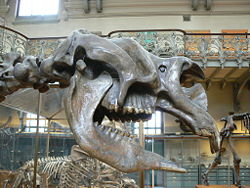Diprotodon
Diprotodon was the largest marsupial that ever lived, or at any rate, the heaviest. Its family, the Diprotodontidae, existed from at least 1.6 million years ago until extinction some 40,000 years ago.[1] So it lived through most of the Pleistocene epoch. Its forebears lived in the late Oligocene to early Miocene roughly 23 million years ago.
| Diprotodon Temporal range: Pleistocene
| |
|---|---|

| |
| Scientific classification | |
| Kingdom: | |
| Phylum: | |
| Class: | |
| Infraclass: | |
| Order: | |
| Suborder: | |
| Family: | |
| Genus: | Diprotodon Owen, 1838
|
Diprotodon looked like a rhino without a horn. Its feet turned inwards like a wombat’s, giving it a pigeon-toed appearance. It had strong claws on the front feet, so it may have been able to dig up roots to eat. Footprints of its hairy feet have been found, so we know it had fur like a horse rather than being bald like a rhino. Diprotodon is found in sites all over Australia, but not in Tasmania.
Female skeletons have been found with babies where the mother's pouch would have been.[2] The largest specimens were hippopotamus-sized: about 3 metres (9.8 ft) from nose to tail, standing 2 metres (6.6 ft) tall at the shoulder and weighing about 2,790 kilograms (6,150 lb).[3]
The animal was semi-aquatic with a life-style rather like a hippo. Its extinction may have been caused by the extreme drought conditions, as well as pressure from the first Aboriginal Australians.
Diprotodon Media
Early reconstruction of Diprotodon by Alice B. Woodward, 1912
Illustration of a Diprotodon fossil in the dry lakebed of Lake Callabonna
Diprotodon may have evolved from Euryzygoma (skull above).
Diprotodon skull at the Natural History Museum, London
Diprotodon molars
Mounted skeleton, Museums Victoria
Diprotodon sculpture at the Australian Museum
One Diprotodon herd was making seasonal migrations along the Condamine River (above).
Fossil tracks from the Victorian Volcanic Plain site: a) Protemnodon, b) Diprotodon pes, c) Diprotodon overlain by a vombatid, d) Thylacoleo
References
- ↑ Roberts R.G. et al 2002. (2001). "New ages for the last Australian megafauna: continent-wide extinction about 46,000 years ago" (PDF). Science. 292 (5523): 1888–1892. Bibcode:2001Sci...292.1888R. doi:10.1126/science.1060264. PMID 11397939. S2CID 45643228. Retrieved 26 August 2011.
- ↑ "Science & Nature: Animals: Diprotodon". Official website. British Broadcasting Corporation (BBC). July 2008. Retrieved 24 February 2011.
- ↑ Ice age marsupial topped three tons, scientists say. Retrieved 17 September 2003.
Other websites
| Wikimedia Commons has media related to Lua error in Module:Commons_link at line 62: attempt to index field 'wikibase' (a nil value).. |
| Wikispecies has information on: Diprotodon. |








